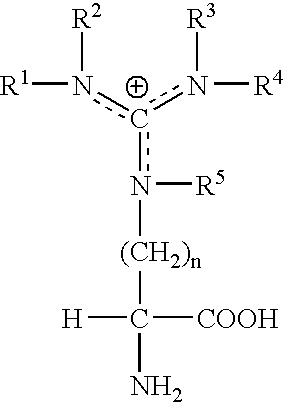Tumor targeting agents and uses thereof
a technology of tumor targeting and tumor cells, applied in the field of tumor targeting agents, can solve the problems of requiring a huge number of lives every year, limited treatment methods of cancer, and rarely achieving curative treatment, and achieve the effect of increasing the differentiation degree stabilizing or solubility enhancement of the effector uni
- Summary
- Abstract
- Description
- Claims
- Application Information
AI Technical Summary
Benefits of technology
Problems solved by technology
Method used
Image
Examples
example 1
Synthesis of a Targeting Unit (Peptide) LRS
[0318] A functionally protected, resin bound targeting unit (protected peptide), comprising targeting motif LRS, was synthesized using the method described in Example 2.
[0319] The following reagents were employed as starting materials (in this order):
Fmoc-Ser(tBu) Resin, Applied Biosystems Cat. No. 401429, 0.64 mmol / g
Fmoc-L-Arg(Pbf)-OH, CAS No. 154445-77-9, Applied Biosystems Cat. No. GEN911097, Molecular Weight: 648.8 g / mol
Fmoc-L-Leu-OH, CAS No. 35661-60-0, Applied Biosystems Cat. No. GEN911048, Molecular Weight: 353.4 g / mol
[0320] After the last cycle of the coupling process, a small sample of the resin bound peptide was subjected to Fmoc removal (steps 1-10 in Example 2), after which the peptide was cleaved off the resin by a three hours' treatment with the cleavage mixture and isolated as described in Example 2. The product (LRS) was identified with the aid of its positive mode MALDI-TOF mass spectrum, in which the M+1 ion of L...
example 2
General Description of the Manual Solid Phase Peptide Synthesis and Mass Spectral Measurements Used for Synthesising Peptides Described in the Examples
[0321] All synthetic procedures were carried out in a sealable glass funnel equipped with a sintered glass filter disc of porosity grade between 2 and 4, a polypropene or phenolic plastic screw cap on top (for sealing), and two PTFE key stopcocks: one beneath the filter disc (for draining) and one at sloping angle on the shoulder of the screw-capped neck (for argon gas inlet).
[0322] The funnel was loaded with the appropriate solid phase synthesis resin and solutions for each treatment, shaken powerfully with the aid of a “wrist movement” bottle shaker (Gallenkamp™) for an appropriate period of time, followed by filtration effected with a moderate argon gas pressure.
[0323] The general procedure of one cycle of synthesis (=the addition of one amino acid unit) was as follows:
[0324] An appropriate Wang or Rink (Rink amide) resin, loa...
example 3
General Procedures for I2-Promoted Cyclization of Cystein Comprising Peptides Described in the Examples
[0359] The resin (1 g) was swelled on CH2Cl2 (15 ml) and stirred for 20 minutes. The solvent was removed by filtration and the resin was treated once with DMF (15 ml) for three minutes. After filtration, the resin-bound peptide (or targeting agent) was treated with iodine (5 molar equivalents) in DMF (10 ml) for 1 hour.
[0360] The DMF-iodine solution was removed by filtration and the residue was washed three times with DMF (15 ml) and three times with CH2Cl2 (15 ml) for 3 minutes each time.
[0361] In case that a ‘plain’ peptide (without the Fmoc group) was to be prepared, the Fmoc group was removed and the peptide was released from the resin according to the general procedure described in Example 2 and purified by reversed phase HPLC. In the case of targeting agents comprising no Fmoc group, the product was released from the resin and purified analogously.
[0362] Material used:
...
PUM
| Property | Measurement | Unit |
|---|---|---|
| concentration | aaaaa | aaaaa |
| concentration | aaaaa | aaaaa |
| concentration | aaaaa | aaaaa |
Abstract
Description
Claims
Application Information
 Login to View More
Login to View More - R&D
- Intellectual Property
- Life Sciences
- Materials
- Tech Scout
- Unparalleled Data Quality
- Higher Quality Content
- 60% Fewer Hallucinations
Browse by: Latest US Patents, China's latest patents, Technical Efficacy Thesaurus, Application Domain, Technology Topic, Popular Technical Reports.
© 2025 PatSnap. All rights reserved.Legal|Privacy policy|Modern Slavery Act Transparency Statement|Sitemap|About US| Contact US: help@patsnap.com



